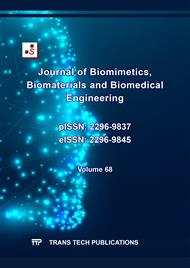[1]
R. Agarwal, C. Gonzalez-García, B. Torstrick, R.E. Guldberg, M. Slmerón-Sánchez, A.J. García, Simple coating with fibronectin fragment enhances stainless steel screw osseointegration in healthy and osteoporotic rats. Biomaterials. 63 (2015). 137-145
DOI: 10.1016/j.biomaterials.2015.06.025
Google Scholar
[2]
T. Sözen, L. Özışık, N.Ç. Başaran. An overview and management of osteoporosis. Eur J Rheumatol. 4 (2017). 46-56
DOI: 10.5152/eurjrheum.2016.048
Google Scholar
[3]
D. Patel, B. Saxena. Decoding osteoporosis: Understanding the disease, exploring current and new therapies and emerging targets. 4 (2025). 1-20. https://doi.org/10.1016/j.jorep.2024. 100472
DOI: 10.1016/j.jorep.2024.100472
Google Scholar
[4]
L.G. Oliveira, M.L.R.G. Carneiro, M.P.G. de Souza, C.G.de Souza, F.B. de Moraes, F.L. de Camargo. Osteoporosis Drug Treatment Update. Rev. bras. ortop. 56 (2021)
DOI: 10.1055/s-0040-1714219
Google Scholar
[5]
Y. Wang, L. Yang, C. Li, H. Sun. The Biomechanical Properties of Cement-Augmented Pedicle Screws for Osteoporotic Spines. Global Spine J. 12 (2021). 323-332
DOI: 10.1177/2192568220987214
Google Scholar
[6]
M. Hollensteiner, S. Sandriesser, E. Bliven, C. von Rüden, P. Augat. Biomechanics of Osteoporotic Fracture Fixation. Curr Osteoporos Rep. 17 (2019). 363-374
DOI: 10.1007/s11914-019-00535-9
Google Scholar
[7]
Y. Yao, H. Yuan, H. Huang, J. Liu, L. Wang, Y. Fan. Biomechanical design and analysis of auxetic pedicle screw to resist loosening. Computers in Biology and Medicine. 133 (2021) 104386
DOI: 10.1016/j.compbiomed.2021.104386
Google Scholar
[8]
I. Konstantinidis, G.N. Nadkarni, R. Yacoub, A. Saha, P. Simoes, C. R. Parikh, S. Coca, C.G. Parikh, S.G. Coca. Representation of Patients with Kidney Disease in Trials of Cardiovascular Interventions. JAMA Internal Medicine. 176 (2016). 121-124
DOI: 10.1001/jamainternmed.2015.6102
Google Scholar
[9]
B. Schliemann, N. Risse, A. Frank, M. Müller, P. Michel, M. J. Raschke, J.C. Katthagen, J. C. Screws with larger core diameter and lower thread pitch increase the stability of locked plating in osteoporotic proximal humeral fractures. Clinical Biomechanics. 63 (2019). 21–26
DOI: 10.1016/j.clinbiomech.2019.02.006
Google Scholar
[10]
A. Kundoo, V. Dodwad. Effects of Implant Thread Design Around Tissues of Implant. Acta Scientific Dental Scienecs. 7 (2023). 92–100. https://actascientific.com/ASDS/pdf/ASDS-07-1687.pdf
DOI: 10.31080/asds.2023.07.1687
Google Scholar
[11]
C.A. Andreucci, E.M.M. Fonseca, R.N. Jorge. Increased Material Density within a New Biomechanism. Mathematical and Computational Applications. 27 (2022). 1-9
DOI: 10.3390/mca27060090
Google Scholar
[12]
ASTM Standards, F543-07. Standard specification and test methods for metallic medical bone screws, 2002.
Google Scholar
[13]
T. Demir, N. Camusxcu, K. Tu¨reyen. Design and biomechanical testing of pedicle screw for osteoporotic incidents. J Engineering in Medicine. 226 (2012). 256-262
DOI: 10.1177/0954411911434680
Google Scholar
[14]
S. Bennie, J.D. Crowley, T. Wang, M.H. Pelletier, W.R. Walsh. Pedicle screw pull-out testing in polyurethane foam blocks: Effect of block orientation and density. Proc Inst Mech Eng H. 238 (2024). 455–460
DOI: 10.1177/09544119241236873
Google Scholar
[15]
Samirah, N.K. Yasmin, A.S. Budiatin, D.M.N. Ratri, A.N. Fauziyah, T. Aryani, D.W. Shinta. Mechanical characterisation of polylactic acid-alendronate bioscrew in different concentrations of glutaraldehyde. Pharmacy Education. 24 (2024). 101- 104
DOI: 10.1177/09544119241236873
Google Scholar
[16]
Y. Amaritsakula, C.K. Chaoa, J. Linb. Biomechanical evaluation of bending strength of spinal pedicle screws, including cylindrical, conical, dual core and double dual core designs using numerical simulations and mechanical tests. Medical Engineering & Physics. 36 (2014) 1218–1223
DOI: 10.1016/j.medengphy.2014.06.014
Google Scholar
[17]
T. Kima, C.W. See, X. Li, D. Zhu. Orthopedic implants and devices for bone fractures and defects: Past, present and perspective. Engineered Regeneration. 1 (2020). 8-16
DOI: 10.1016/j.engreg.2020.05.003
Google Scholar
[18]
A.S. Budiatin, M.A. Gani, B.R.K.H. Putri, S. Samirah, D. Hikmawati, A.P. Putra, N. Su'aidah, J. Khotib. In vivo study of bovine hydroxyapatite-gelatin-hydroxypropyl methylcellulose with alendronate as injectable bone substitute composite in osteoporotic animal model. J Adv Pharm Technol Res. 13 (2002). 261-265
DOI: 10.4103/japtr.japtr_266_22
Google Scholar
[19]
W. Weriono, M. Rusli, R.E. Sahputra, H. Dahlan. Pedicle Screw Bond Strength and Resistance Characteristics with Various Mineral Quality. TEM Journal. 13 (2024). 809-817
DOI: 10.18421/TEM131-83
Google Scholar
[20]
P.E. Chatzistergos, E.A. Magnissalis, S.K. Kourkoulis. A parametric study of cylindrical pedicle screw design implications on the pullout performance using an experimentally validated finite-element model. Medical Engineering & Physics. 32 (2010). 145-154
DOI: 10.1016/j.medengphy.2009.11.003
Google Scholar
[21]
F. Shen, H.J. Kim, K.T. Kang, J.S. Yeom. Comparison of the Pullout Strength of Pedicle Screws According to the Thread Design for Various Degrees of Bone Quality. Applied Sciences. 9 (2019). 1-11
DOI: 10.3390/app9081525
Google Scholar
[22]
J.K. Biswas, T.P. Sahu, M. Rana, S. Roy, S.K. Karmakar, S. Majumder, A. Roychowdhury. Design factors of lumbar pedicle screws under bending load: A finite element analysis. Biocyberntics and Biomedical Engineering. 39 (2019). 52-62
DOI: 10.1016/j.bbe.2018.10.003
Google Scholar
[23]
X. Feng, Z. Luo, Y. Li, Y. Yao, W. Qi, B. Chen, H. Liang. Fixation stability comparison of bone screws based on thread design: buttress thread, triangle thread, and square thread. BMC Musculoskeletal Disorders. 23 (2022). 1-10
DOI: 10.1186/s12891-022-05751-6
Google Scholar
[24]
Y. Okazaki, E. Hayakawa, K. Tanahashi, J. Mori. Mechanical Performance of Metallic Bone Screws Evaluated Using Bone Models. Materials. 13 (2020). 1-21. https://doi.org/10.3390/ ma13214836
DOI: 10.3390/ma13214836
Google Scholar
[25]
V. Goanta. Device for Torsional Fatigue Strength Assessment Adapted for Pulsating Testing Machines. Sensors. 22 (2022). 1-10
DOI: 10.3390/s22072667
Google Scholar
[26]
S. Fu, Y. Zhang, R. Wang, X. Zou, F. Ai, J. Wang, X. Ma, H. Xia, W. Lei. Calcium phosphate cement promotes the stability of osteoporotic lumbar pedicle screw by enhancer-injecters with different number of holes. BMC Surgery. 23 (2023). 1-7
DOI: 10.1186/s12893-023-02235-9
Google Scholar
[27]
T. Demir, N. Camusxcu, K. Tu¨reyen. Design and biomechanical testing of pedicle screw for osteoporotic incidents. 2012. 1-7
DOI: 10.1177/0954411911434680
Google Scholar
[28]
N. A. Noda, X. Chen, Y. Sano, M. A. Wahab, H. Maruyama, R. Fujisawa, Y. Takase. Effect of pitch difference between the bolt–nut connections upon the anti-loosening performance and fatigue life. Materials and Design. 96 (2016) 476–489. https://doi.org/10.1016/ j.matdes.2016.01.128
DOI: 10.1016/j.matdes.2016.01.128
Google Scholar


